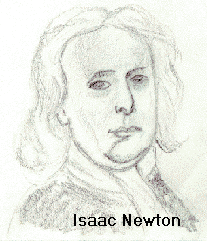The Theoretical Ground Work For Satellites
Cristin M / Physics #336 / 19 May 1997

The theoretical possibilities of a satellite started about, 300 years
before the satellite was developed. There are three men who envisioned
the possibility of a satellite. These men are the early dreamers. Sir Isaac
Newton, Konstan Edvardovich Tsiolkovsky, and Edward Everett Hale each in
their own way helped in the creation of the satellite.
Sir Isaac Newton
The theoretical possibility of establishing an artificial satellite
of earth had been mentioned in 1687 by an English mathematician, Sir Isaac
Newton. This came about because of his work on the theory of gravitation
(Charyk 85). Newton wondered about space travel and knew that the moon
orbited the earth in a circular pattern. He wondered why it didn't trail
off into space. Newton saw an apple fall, and he realized the force pulling
the apple to the ground also reaches into space. He also realized that
gravity held the moon in orbit. That force is gravity,
all objects have gravity (Vogt 4). This can be said about satellites, "
Despite appearances, satellites do not really defy gravity. They are in
fact falling toward the earth all the time, just like the apple Sir Isaac
Newton watched fall and which led to the discovery of the law of gravity"
(Readers Digest 17). The only real key difference between the apple and
the satellite is that the satellite is moving much faster and at a greater
height. This must mean that as the satellite falls towards earth, the earth's
surface curves away from it, so the satellite never gets closer. If an
apple is thrown towards the horizon, the apple still falls, but it follows
a curved path. Newton felt if the apple was thrown at a great enough speed
the downward curve of the apple's path as it falls will match the curve
of the earth's surface. If the apple is always and the earth's surface
is always curving underneath at the same rate, the result is that the apple
never gets closer to the surface of the earth. The apple is in orbit (Readers
Digest 171 ). Newton demonstrated how an artificial satellite could be launched
above earth. "He pictured the earth with a high mountain. A canon
on top of the mountain fired shots parallel to the ground. Each time the
canon was fired, more gun powder was used and the shot went farther before
striking the ground" (Vogt 4). Since the earth is round shots curved
around it. Newton's theory stated that shot could in fact go so fast, it
could circle the earth and could come back to the mountain top. Newton
showed that the force pushing the canon shot outward was also balanced
by gravity's inward pull. This was used later in proving that a shot could
circle earth (Vogt 5).
Konstantin Tsiolkovsky
Decades ahead of his time, Konstantin forecasted many features of modern
astronautics. Including satellites. Konstantin was a visionary Russian
theorist and wrote about space travel. He was deaf from a childhood illness,
called Scarlet fever. He taught himself and became a high school math teacher
(Oberg 85). As early as 1883 he was writing articles on space flight. He
wrote science fiction accounts on space adventure, in which he accurately
described artificial satellites. Some of these works include on the moon
dreams of the earth and the sky and beyond the earth (Oberg 85). Early
in the twentieth century pioneers experimented with rockets, as means to
get into space. Konstantin designed a multi stage rocket. In 1896 he explored
the possibility of interplanetary travel by rockets. In one of his works
he set forth his theory of motion of rockets, established the possibilities
of space travel by means of rockets, and the fundamental flight formulas
he came up with (Grigorian 483). The theoretical work of Konstantin confirmed
that a satellite might be launched by means of a rocket. In the mid 1920's
his works on rocket engineering and space flight won international recognition
(Grigorian 484).
Edward Everett Hale
Edward Everett Hale is believed by some to be the first to propose
the idea for satellites. He was an American clergyman and also a writer.
In one of his books, The Brick Moon, other stories published in
1899, he proposed the idea of an artificial satellite (Demis 71).
Importance of The Early
Dreamers
The early dreamers of satellites were an intricate part in the development
of the artificial satellite. With ideas of Hale and the first satellite,
along with the discovery of gravity by Newton, and the ideas for propelling
the satellite with a rocket by Konstantin they all led to the development
of an artificial satellite.
References
Charyk, Joseph and Sidney Metaphor. "Satellite, Artificial."
Barnes and Noble New American Encyclopedia. Chicago : Grolier, 1991.
Cooper, Heather and Nigel Henbest. How the Universe Works.
London: Dorling Kindersley Limited, 1994.
Demis, Richard. "Satellite" Comptons Encyclopedia and
Fact Index Chicago: World Book Inc., 1996
Grigorian, A.T. "Tsiolkovsky, Konstantin Edvardovich."
Dictionary of Scientific Biography. New York: Charles Scribher's Sons, 1976.
Oberg, James E. "Tsiolkovsky, Konstantin " Barnes and
Noble New American Encyclopedia. Chicago: Grolier, 1991.
Paulsen, F. M. "Hale, Edward Everett." Barnes and Noble
New American Encyclopedia. Chicago: Grolier, 1991.
Reader's Digest. How in the world? New York: The Reader's Digest
Association, Inc., 1990.
Vogt, Gregory. Space Satellites. New York: Franklin Watts Inc.,
1987.